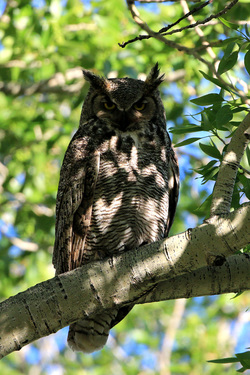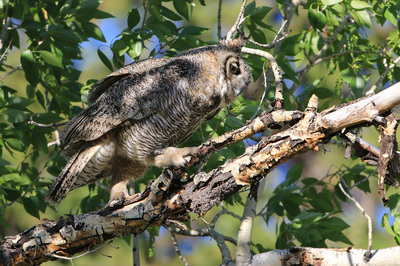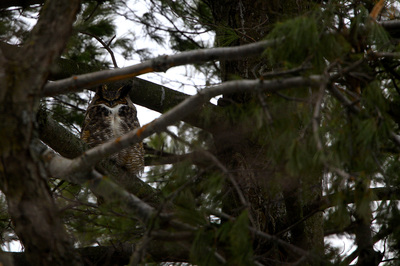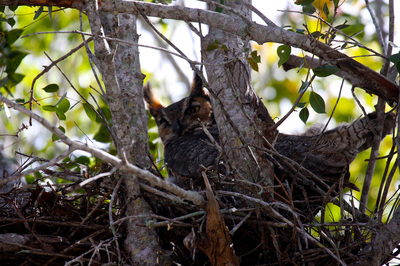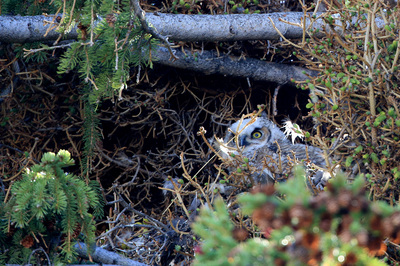Great Horned OwlIt is not particularly wise despite what children’s books say. Nor it is somehow connected to a magical world where it can foretell events. It is however our most common owl and our largest. Bubo virginianus, literally the owl of Virginia, was one of the first American owls described back in the early 1600’s. Today we know it as the Great Horned owl but even this is misleading as it does not have horns but merely feather tufts on the top of its head.
Just about wherever you fish you will be likely be fishing in the territory of a Great Horned owl. They happily nest in a stand of cottonwoods along a prairie river or deep in a boreal forest. They nest in farm lands and city parks, mountain valleys and deserts. Their range extends from Alaska to the Patagonia in South America and from coast to coast in North America absent only from the tundra. In North America they are one of the first birds to nest in winter. As I write this in early February the local owls are already on nests or soon will be. White old hawk or eagle nests are preferred they will nest on cliff ledges, tree hollows or even on a large cactus. Up to 4 eggs are laid but when the young hatch after about a month the first owlet will often force its siblings out of the nest if the parents are not able to provide enough food for their brood. In good years most survive but good years are rare. At 6 to 8 weeks the youngsters fledge but this is a time where their survival is most vulnerable. When they leave the nest they cannot fly and an owlet that winds up on the ground may be taken by a predator. Land too low in a tree in the boreal forest and mosquitos may weaken them. The parents will try and bring them food but it a precarious time of their lives. The young are on their own when they are about 5 months old. Male owls begin to call in November. They are letting other owls know that this is their territory. A female, if she is impressed with the male’s area, will accept him as a mate. They will then stay together until late summer when they will both leave their territory to search for food. They are not thought to be monogamous and pair bonds seem to last only for the breeding season. They are our largest owls but even so there can be quite a range in size from 680 g to 2,503 g (1.499 to 5.518 lb). They look larger than they really are. Prey ranges from small rodents to rabbits and hares, mink, skunks, opossums, birds, reptiles and amphibians. They have primary feathers that do not link up the same way as most bird’s flight feathers do and as a result their flight is very quiet. No telltale whoosh of a wing. Even a chickadee makes a greater noise when it takes off than on owl does. The silence of their flight is extraordinary. Their eyesight is good during the day but is well developed for night. They cannot see on a pitch dark night but with just a few stars out they are able to hunt. Their ears are offset on the sides of their head and this allows them to locate prey by sound alone. This is especially useful in the winter when their prey may be hiding beneath the snow. If you are out and you hear a murder of crows cawing or see them circling a tree look for an owl. Crows hate owls and will mob them whenever they come across one. The owls will swoop in on sleeping crows at night, unseen, unheard so the hatred is understandable. Note: A version of this article first appeared in Bob Izumi's Real Fishing Magazine in Dave's column At the Water's Edge. It is used with the permission of editor. |
|
All images and text are copyright © 2016 J.D. Taylor Senses of Wildness Inc. These images may not be used in any form without permission. All rights reserved.
